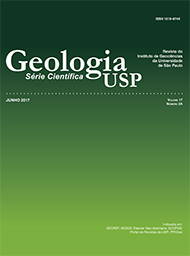As formações ferríferas bandadas proterozoicas de Guanhães, borda sudeste do Cráton São Francisco, Brasil: evidências de contaminação detrítica
DOI:
https://doi.org/10.11606/issn.2316-9095.v17-352Palavras-chave:
Formações Ferríferas Bandadas, Guanhães, Geocronologia, Geoquímica.Resumo
A sequência supracrustal Guanhães, portadora de formações ferríferas bandadas (BIFs), ocorre como fatias tectônicas superpostas ao embasamento de terrenos granito-gnáissicos do tipo TTG de idade Arqueana, desenvolvidas no limite entre o período Proterozoico e o Paleozoico, durante a colagem Brasiliana. A idade máxima de deposição da sucessão é de ~2,18 Ga e foi determinada por datação de zircões detríticos em quartzitos. Além de quartzitos, a sucessão é composta por xistos, BIFs, gnaisses e anfibolitos, todos metamorfisados em condições de fácies anfibolito. A análise dos Elementos Terras Raras + Y (ETR+Y), normalizados ao PASS, para as BIFs de Guanhães, mostra enriquecimento em ETR pesados e anomalia positiva de Eu. Dois tipos de contaminação foram observados nas amostras. O primeiro é uma contaminação detrítica que resultou em baixos valores de Y/Ho (< 30) e Pr/Yb (SN). As evidências de contaminação desse tipo, combinadas à análise do empilhamento estratigráfico do pacote de rochas supracrustais, indicam que as BIFs de Guanhães foram depositadas em ambiente marinho raso. Um evento Cambriano expressivo está presente nos dados relativos à datação de zircões. O segundo tipo de contaminação resultou em maiores valores de anomalia de Eu, anomalia positiva de Ce e maiores concentrações de ETR, possivelmente devido à interação entre fluidos magmáticos posteriores e as BIFs de Guanhães. As amostras sem contaminação mostram distribuição de ETR semelhante a outras BIFs Précambrianas, particularmente às BIFs da Sequência do Morro Escuro e do Grupo Serra da Serpentina, com ausência de anomalia verdadeira de Ce e Y/Ho próximo aos valores da água do mar (45). Os dados geocronológicos e geoquímicos apresentados neste artigo sugerem correlação entre a sucessão supracrustal de Guanhães (GSSu) e os Grupos Serra da Serpentina e Serra de São José.
Downloads
Downloads
Publicado
Edição
Seção
Licença
Autores que publicam nesta revista concordam com os seguintes termos:
- Autores mantém os direitos autorais e concedem à revista Geologia USP. Série Científica, o direito de primeira publicação, com o trabalho sob a licença Creative Commons BY-NC-SA (resumo da Licença: https://creativecommons.org/licenses/by-nc-sa/4.0 | texto completo da licença: https://creativecommons.org/licenses/by-nc-sa/4.0/legalcode) que permite o compartilhamento do trabalho de forma não comercial e conferindo os devidos créditos autorais da primeira publicação nesta revista.
- Autores têm autorização para assumir contratos adicionais separadamente, para distribuição não-exclusiva da versão do trabalho publicada nesta revista (publicar em repositório institucional ou como capítulo de livro), conferindo os devidos créditos autorais da primeira publicação nesta revista.
- Autores têm permissão e são estimulados a publicar e distribuir seu trabalho online (em repositórios institucionais ou na sua página pessoal) a qualquer ponto antes ou durante o processo editorial, uma vez que isso pode gerar alterações produtivas, bem como aumentar o impacto e a citação do trabalho publicado (Veja O efeito do Acesso Aberto e downloads no impacto das citações).















